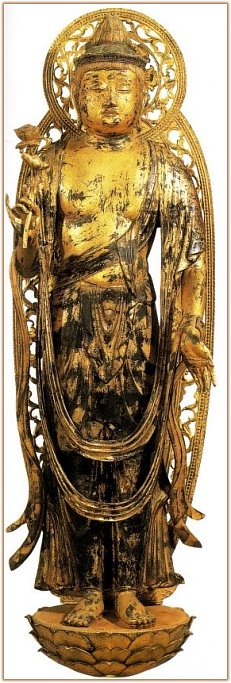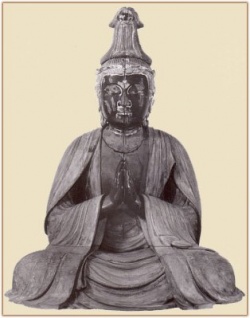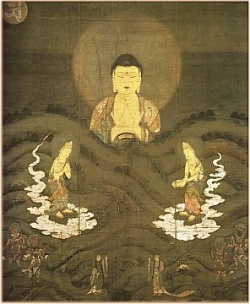Seishi Bosatsu (Bodhisattva)
Seishi Bosatsu, Seishi Bodhisattva, Daiseishi (Seishi 勢至 lit. = "to obtain strength")
| English | Japanese | Chinese | Sanskrit / Pali | Korean | Tibetan |
|---|---|---|---|---|---|
| Bodhisattva of Strength Bosatsu of Wisdom |
Seishi 勢至菩薩 Daiseishi 大勢至 Tokudaiseishi 得大勢至 Tokudaisei 得大勢 |
Shìzhì, Shizhi, Shih Chih, Da Shì Zhì, Ta-shih-chih |
महास्थामप्राप्त Mahasthamaprapta, Mahāsthāmaprāpta, Mahasthama |
Daeseji bosal, Dae Sae Zhi 세지 |
Phyag na rdo rje |
- Origin = India
- One of two main attendants to Amida Buddha, appearing frequently in artwork known as the Amida Sanzon 阿弥陀三尊 (lit. = Amida Triad). Seishi is typically placed to the right of the central Amida image, but sometimes (e.g., Immeasurable Life Sutra) Seishi appears on the left.
- One of 25 Bodhisattva who descent from heaven (raigō) with Amida to welcome dying souls into Amida's Pure Land
- One of the Thirteen Deities (Jūsanbutsu) of the Shingon sect invoked in memorial services for the departed.
- One of the Eight Great Bodhisattva (Hachi Daibosatsu or Hachi Bosatsu) who appear in the Taizōkai Mandala and Butsugen Mandala.
- Guardian of People Born in Zodiac Year of the Horse.
- In Tibetan Buddhism, Mahāsthāmaprāpta (aka Seishi) is equated with Vajrāpani (aka Niō).
- In Tibet, Vajrāpani is considered an incarnation (manifestation) of Seishi.
Seishi appears in early Mahayana sutras, including the Immeasurable Life Sutra, the Meditation Sutra, and the Lotus Sutra. Seishi did not gain great popularity in India, but in China and Japan, Seishi's importance grew with the spread of the Pure Land sects devoted to Amida Buddha, for Seishi is one of the two main attendants (kyōji 脇侍) of Amida Buddha. The other is Kannon. In Japan, the three appear in a popular grouping known as the Amida Sanzon 阿弥陀三尊 (lit. = Amida Triad), with Amida in the center, Seishi to the right (representing wisdom), and Kannon to the left (representing compassion). Even today, the Pure Land sects of Japan are among the nation's largest and most popular. Nevertheless, in both China and Japan, Seishi has always been eclipsed in popularity by Kannon (the God/Goddess of Mercy).
Seishi is rarely represented in Japanese sculpture except for the Amida Triad. In triad artwork, Kannon's crown often contains a small image of Amida, which symbolizes compassion. Seishi's crown often shows a small water vase (suibyō 水瓶), which symbolizes wisdom, a virtue that is perhaps religiously less significant than compassion, and this may help to explain why Seishi is not widely revered outside of Japan's Pure Land traditions. Another reason may be the vast popularity once enjoyed by Monju Bosatsu (the Bodhisattva of Supreme Wisdom, the Wisest of the Bodhisattva).
Seishi is also one of the 13 Buddha 十三仏 (Jūsanbutsu) of the Shingon Sect of Esoteric Buddhism (Mikkyō 密教) in Japan. In this role, Seishi presides over the memorial service held on the first-year anniversary following one's death. Seishi is also portrayed in the Rengebu-in 蓮華部院 section of the Womb World Mandala of Japan's Esoteric sects. In the Lotus Sutra, Seishi is listed among those who assembled on Eagle (Vulture) Peak to listen to the teachings of the Historical Buddha. Eagle Peak is located near the modern-day Indian city of Rajagrha, and is the spot where the Historical Buddha often preached.
Mantra
Japanese Mantra for Seishi Bosatsu
- On Sanzansaku Sowaka (also Om Sanzansaku Sowaka)
Seishi in Japanese Art
Seishi Bodhisattva appears mostly in paintings and sculptures of the Amida Triad, where Amida Buddha is seated in the center, attended by Seishi on the right and Kannon on the left. Seishi is typically depicted with hands held together in prayer (gasshō mudra 合掌), or holding a lotus flower. Sometimes there is a water jar in Seishi's crown (suibyō 水瓶), which represents wisdom. Belief in Amida Buddha and Amida's Pure Land was popular among the Japanese court in the late Heian Period, but it was only in the Kamakura era that Amida faith became popular among the common people.
Raigō 来迎 (Heavenly Descent) & Raigō Artwork
Raigō (Raigo) literally means "coming in welcome." Raigō artwork typically depicts Amida, Seishi, and Kannon descending from the Pure Land (heaven) on clouds to welcome the faithful into Amida's Pure Land of Utmost Bliss (Jp. = Jōdo, Jp. = Gokuraku; Skt. = Sukhavati). Seishi is also counted, along with Kannon, as one of the 25 Bodhisattva 二十五菩薩 (Jp. = Nijūgo Bosatsu) who are often depicted in Japanese paintings of Amida's decent. They join Amida in leading the faithful spirits of the departed back to Amida's Pure Land.
IMPORTANT STATUES OF SEISHI BOSATSU IN JAPAN
- Ninnaji Temple 仁和寺 (Kyoto); Heian Period, National Treasure.Seishi as part of an Amida Triad. Wood, H = 124.2 cm
- Konbuin Temple 興福院 (Nara); Nara Era statue. Seishi as part of an Amida Triad. Wood-core dry lacquer (Mokushin Kanshitsu 木心乾漆). H = 75.4 cm. Important Cultural Treasure.
- Sanzenin 三千院 (Kyoto); Dated 1148 AD, National Treasure. Seishi as part of an Amida Triad. Wood, H = 131.8 cm
- Jōdoji (Jodoji) Temple 浄土寺 (Hyōgo Prefecture); Dated +1197. Amida Triad by Kaikei. Seishi as part of an Amida Triad. Lacquer and gold leaf over wood.
- Amida Nyorai Triad (Sanzon), 1148 AD, Byōdō-in Temple. See Bosatsu on Clouds page for more photos and details.


